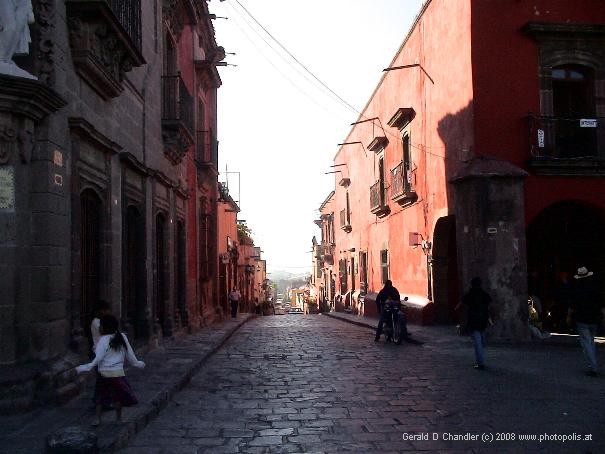Home | Front Page | Blog | Index | New | Contact | Site Map
NuevoLeon
Coahuila
Chihuahua
Sonora
Durango
Jalisco
Sinaloa
Zacatecas
San Luis Potosi
Queretaro
Guanajuato
Michoacan
Guerrero
Morelos
Puebla
Tlaxcala
Oaxaca
Chiapas
Campeche
Yucatan
Quintana Roo
Teotenango
Xochicalco
Monte Alban
Mitla
Palenque
Uxmal
Chichen Itza
Tolum
Belize Mayans
Tikal
Copan
General Topics
Churches
Beach Bumming
Swimming Along
States
Websites
Map
Car Costs
> USA-Britain
USA 2003
USA 2002
Britain 2002

Virgin of San Miguel de Allende
|
Like Moses' brother Aaron, after long journeys through the literal and figurative desert, we have reached what may be the promised land of Mexic. While we enjoyed our first months in Mexico, particularly the depths of the Copper Canyons and some of the beaches on the Pacific coast, we never felt that those parts of Mexico were world-class attractions. But here in the high plateau ("el altiplano") northwest of Mexico City, in the heart of colonial, silver-mining Mexico, we have found it.
If you were put off Mexico by our tongue-in-cheek story of woe entitled "The Sting of Mexico" change your mind and come to Zacatecas, Real de Qatorce, San Luis Potosi, Queretaro, San Miguel de Allende, Guanajuato, and Guadalajara. If you like beautiful churches, romantic streets, interesting modern and ancient museums, and nice temperatures, you'll love this part of Mexico.
The entire area is at a high altitude, largely above 6,000 ft (1,800 meters), overlapping the continental divide. The result is a year-round climate that is very pleasant. In summer the major part of the annual rain falls; the days are very hot, but the nights are cooler and pleasant. In fall, both days and evenings should be comfortable. In late November and early December, the time of our visit, the days are warm and comfortable, the evenings chilly, requiring sweaters and coats. For us it is perfect as the cool evenings punctuated by Christmas carols, give us a real sense of the Christmas spirit. We should add that although we should not have been, after all Mexico is a majority Catholic country, we were surprised by the extent of the Christmas celebration. But back to our main topic.
Our exploration of the northwest Altiplano began in early October with Guadalajara and surroundings. We had left the tiny resort of Melaque and found ourselves in Ajijic on the shores of Lake Chapala. There we enjoyed two delightful meals and got an introduction to the high plateau weather.
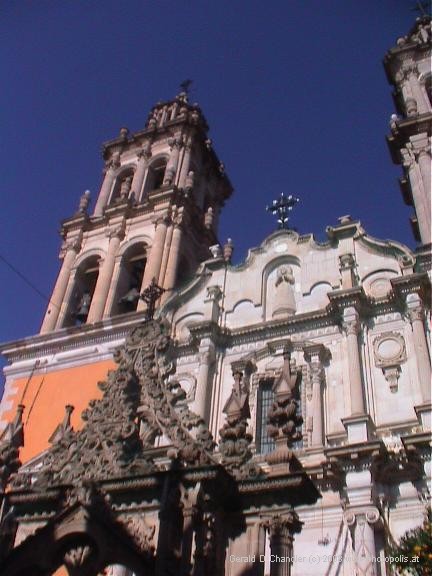
Parroquia de la Inmaculate
|
Thirty miles further north, in Guadalajara, our first impression was negative due to the dreadful traffic noise and pollution. Fortunately parts of the historic core, with narrow streets lined with colonial style buildings, are still mostly intact and to some extent protected from the roar of modernity by pedestrian streets. The old center of Guadalajara has several fine churches, wonderful squares, and fine courtyard houses converted to banks, restaurants, and, in at least one case, a hotel — one where we stayed.
We remained long enough in Guadalajara to participate in the Romeria, the annual procession of the image of the Virgin of Zapopan (much revered throughout Mexico — check out our website) from the Cathedral of Guadalajara to the Temple of Zapopan six kilometers away. We stayed up most of the night, went to dawn mass, and walked about half the distance to Zapopan.
After a day's drive north from Guadalajara through rolling hills we decided to stop in Jerez rather than try to make Zacatecas before dark. We were happy to have done so. Jerez's plaza, church, and old theatre won our hearts. It's a tiny place and a few hours the next morning were enough to see most of it. We met some Americans who have the time to appreciate it more; they have retired there; one was very satisfied with the four room home, half of an old courtyard house, for which he paid $70 a month. We also met a team of three from the national government surveying historic houses in order to protect them.
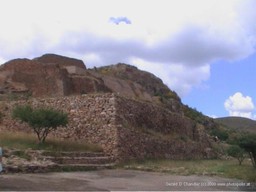
Pyramid at La Quemeda,
|
After an afternoon tour of the ruins of the La Quemada pyramid, we found ourselves in Zacatecas, which we think delightful. Its historic core lies along a narrow valley, about a mile long (1.5 km); there is essentially one street each way so most everything is within walking distance. We stayed in a 300-year-old home, once the property of counts, now converted to a hotel.
When on our first walk we found ourselves in front of the Cathedral, our jaws dropped at the sight of the wonderful Churrigueresque (i.e., Spanish rococo) front. There were to be many other buildings that impressed us, perhaps first among them the ex-monastery of San Francisco, which is now the Museo Rafael Coronel, which contains one of the largest collections of masks in Mexico. We happened to arrive in the city on the first night of a theatre festival and were treated to several free evening shows, of which some were worth more than they cost.
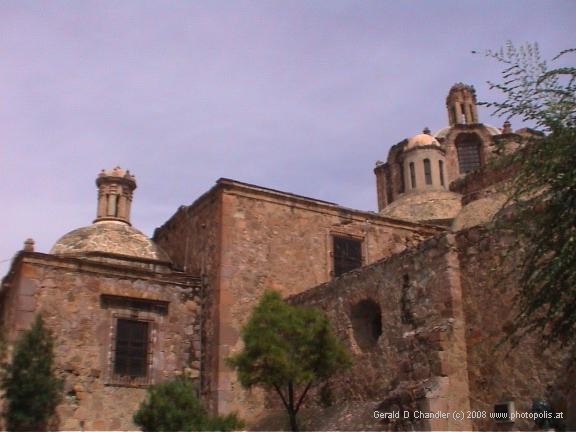
Ex-convent of San Francisco,
|
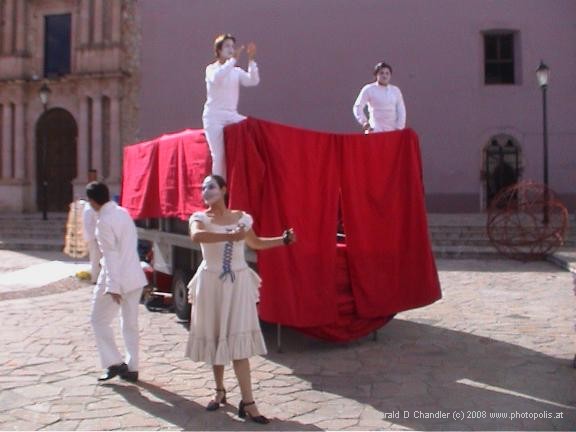
Street Theatre,
Zacatecas
|
Our original intent was to next turn east toward San Luis Potosi. But we put that off for a diversion north to Saltillo, where Gerry revisited a dermatologist he saw in April and to Texas where we managed to replace Gerry's broken camcorder and Jan's flaky notebook computer; stuff ourselves every other day with a Chinese buffet; and about every night stuff ourselves with CNN, C-SPAN and American politics. We drove extra miles to buy the New York Times almost daily.
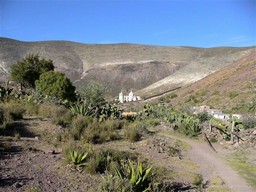
North side of Real de Catorce
|
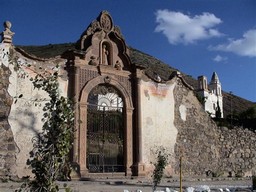
Gate to Church cemetery,
|
Our diversion into Texas made it easy to visit Real de Qatorce, an old mining town that is transforming itself into an artist colony and tourist destination. From our original "circle" it would have been an extra four hours each way that we did not want to spend. But we were glad to see it. Very quaint and starkly picturesque we enjoyed a day wandering its narrow cobblestone streets. Here for the first time we discovered the joy of unheated hotel rooms as the temperature dives with darkness.

Cathedral, San Luis Potosi |

Mariachi Players, San Luis Potosi |
Next (and "at last") was San Luis Potosi (poh-toh-SEE), capital of the state of the same name, which we thoroughly enjoyed. It has an amazing collection of baroque churches and ex-monasteries, a very pleasant historic downtown, and very good tourist infrastructure. There are four or five major squares, each with at least one impressive church on it. We thought the sights were more extensive than Durango and equaled those of Zacatecas. We managed to attend a play in Spanish ("The Mayor of Aldamea", written in the XVII century) at the beautiful Teatro de la Paz. We heard the lighting of the Christmas tree and accompanying fireworks from the warmth of our hotel room.
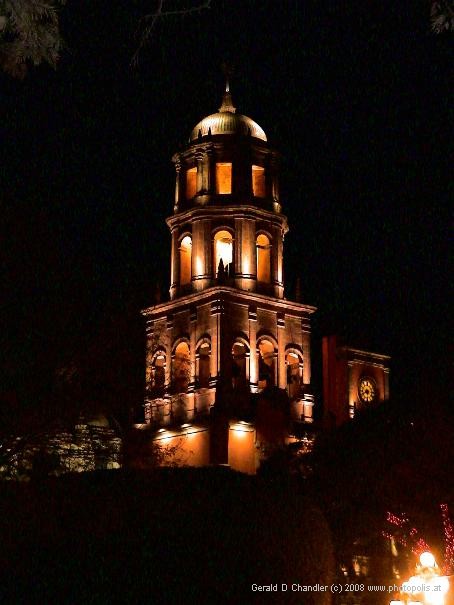
Templo de San Francisco,
Queretaro
|

Courtyard,
Hotel Hidalgo,
|
But better was yet to come. From San Luis Potosi we drove to Queretaro (keh-RE-teh-ro), capital of the state of Queretaro, and arguably the most lovely place we had yet visited. We arrived on the first of December and wandered out of our downtown hotel (which also has a gorgeous courtyard with a fine fountain) a couple of blocks west until we heard Christmas music and discovered an outdoor concert of the municipal choir preceding the lighting of the city's Christmas tree. Several of the streets in the historic downtown have been pedestrianized making it a very pleasant place to wander around. Every two or three blocks there is another lovely square with fountains, trees, benches, cafes and restaurants; usually anchored by a church, museum, or other lovely colonial building. And it was definitely the cleanest big city we have seen so far in Mexico.
Only an hour northwest of Queretaro, across the state border into Guanajuato state, is the once-village of San Miguel de Allende. Made famous by an art school, it is now home at least part of the year to a sizeable American

Parroquia de Nuestra Señora de Dolores, Dolores Hidgago |
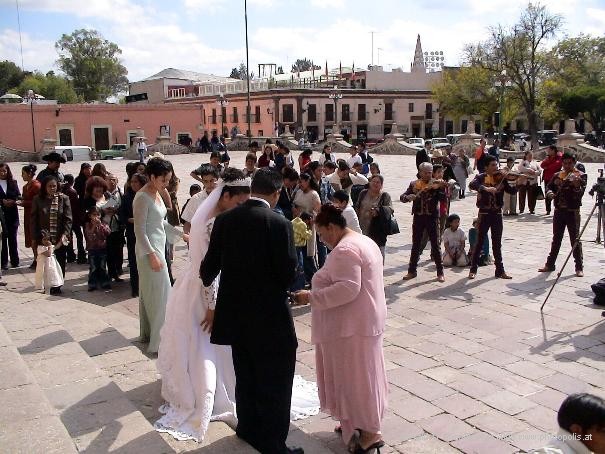
Wedding photographs on Parroquia steps
|
A little less than another hour of driving brought us to Dolores Hidalgo, where in 1810 Miguel Hidalgo was village priest (when he lived there it had not yet been renamed for him) and it was his "grito" (cry of "Viva Mexico") that set off the movement for Mexican independence. We made a brief stop and saw his original church, where before lunch one wedding was ending and after lunch another was begining.
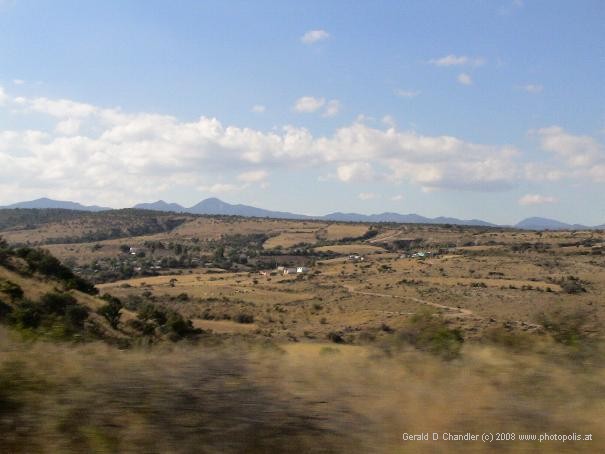
Countryside between Dolores Hidago
|
Then it was off for another hour drive to Guanajuato. This time we climbed some easy hills — a few thousand feet. We love the Mexican countryside; there is endless beauty; this trip was no exception.
On arrival we soon learned first-hand about the tunnels of Guanajuato. We'd been told about them but hadn't appreciated the significance of these space-warps. Like Zacatecas, Guanajuato is built along a narrow valley. To overcome the problem that there is really only room for one street each way in the center, starting a century ago the townsfolks built bypass tunnels. Enter one and end up someplace else. Where? Someplace else. You have to be from here to know where.
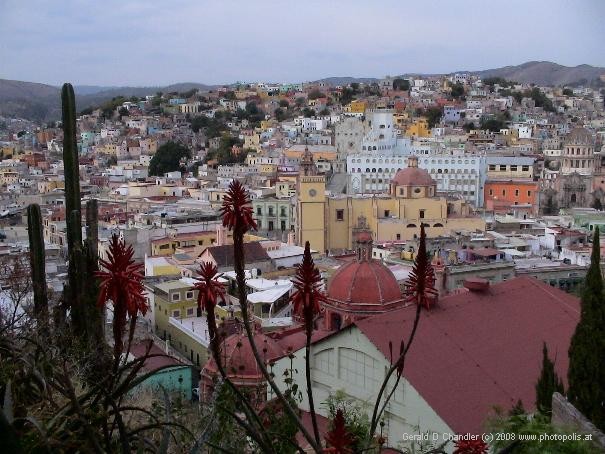
Central Guanajuato seen from path to El Pipala.
|
After three hours of popping in and out (it makes us think of the kids game where a hammer is used to wallop an animal who sticks his head up) and with night falling and thoughts of either being homeless or dinnerless or both, we found a hotel.
Perhaps this is the only place where we would NOT recommend having a car,
unless you already have hotel reservations and very good directions how to get there.
(Although to be fair,
we had problems in Zacatecas too.
Anyway, we park the car and don't use it while in town.)
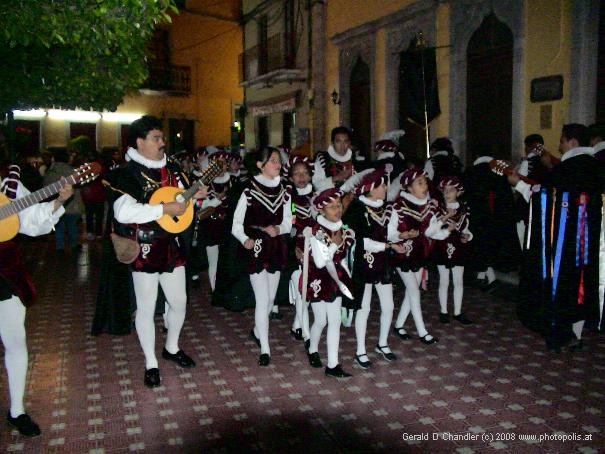
Strolling Players, Guanajuato |
Our first night we wandered down from our hotel and immediately began to experience the magic of the city. On our walk we came across a group of 40 or so wandering minstrels, all dressed in red velvet — it's hard to say whether it looked more like renaissance Florence or characters from a Shakespeare play — who were leading a group of about 40 spectators through the streets and alleys of the city entertaining them as they walked.
On another walk we had another jaw-dropping experience when we saw the interior of the Basilica. We broke our opera drought by attending a top-notch performance of "Madama Butterfly" which we saw in the the Teatro Juarez, a fine building which has a classic horseshoe interior with six or so shallow balconies. It raises our hackles, though, to know that it was built on the site of the monastery of San Diego, demolished by an anti-clerical administration.
With our visit to Guanajuato we are almost back to Guadalajara and have finished as much of the 700-mile circuit as we will. Follow us. Come to the Altiplano. You can do it in two weeks or six weeks or ten and enjoy it anyway. Bring your walking shoes when you come and be prepared to tackle winding, narrow, and sometimes steep streets. But don't be deterred. You can go at your own pace and there is always a friendly place where you can stop for a drink and a rest. And yes, there are plenty of good hotels.
Viva Mexico!
| Guadalajara - Zacatecas | 320 kms | 4-5 hrs |
| Zacatecas - San Luis Pototsi | 190 kms | 3 hrs |
| ** Zacatecas - Real de Qatorce | 300 kms | 4 hrs |
| ** Real de Qatorce - San Luis Potosi | 260 kms | 4 hrs |
| San Luis Potosi - Queretaro | 202 kms | 2.5 - 3.5 hrs |
| Queretaro - San Miguel de Allende | 60 kms | 1hr |
| San Miguel - Dorlores Hidago | 43 kms | 1 hr |
| Dorlores Hidago - Guanajuato | 54 kms | 1 hr |
| Guanajuato - Guadalajara | 296 kms | 4 hrs |
| Circuit total sans Real de Catorce | 1,165 kms (710 miles) | 17 hrs |
| Circuit total with Real de Catorce | 1,535 kms (935 miles) | 22 hrs |


